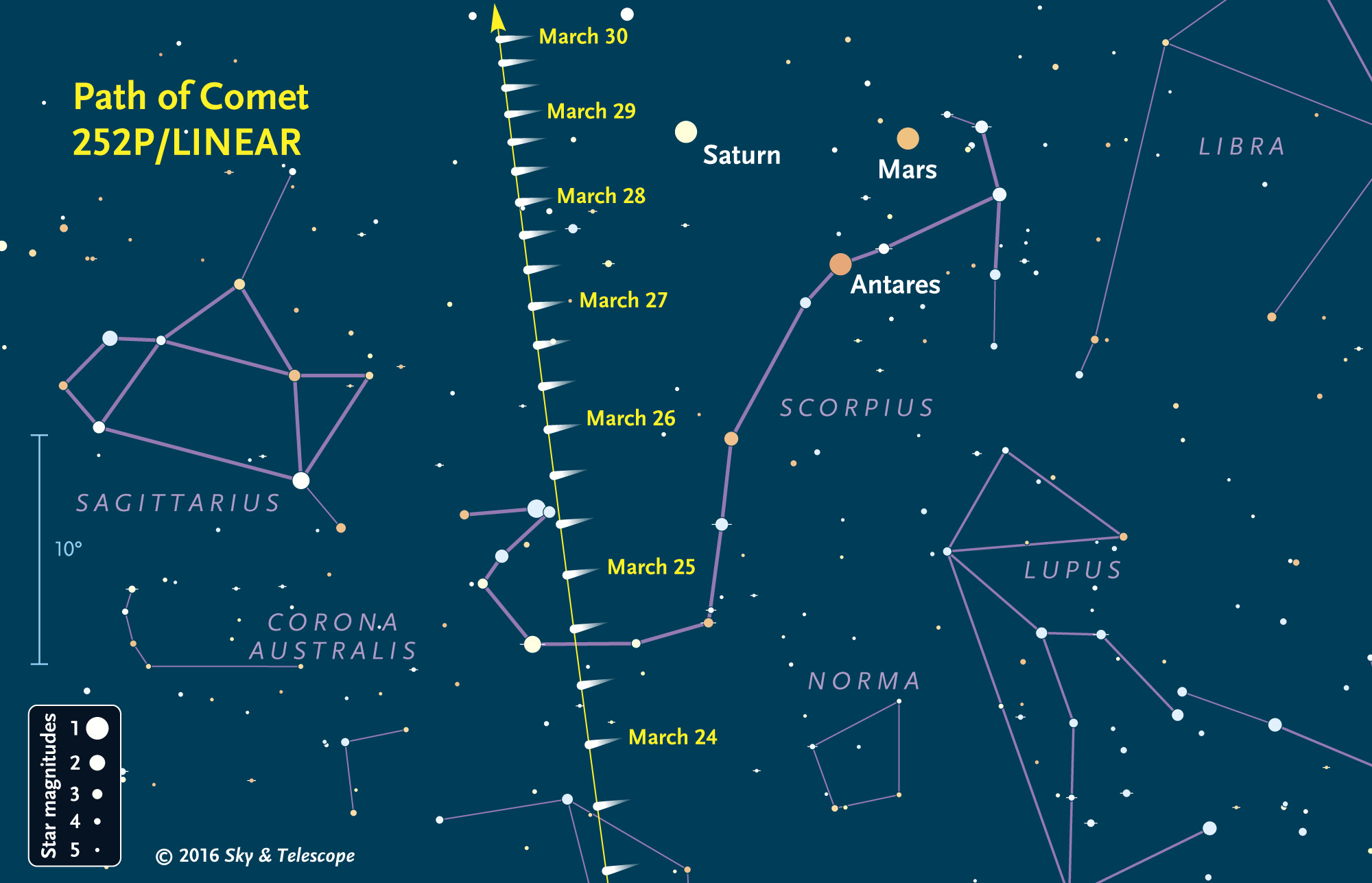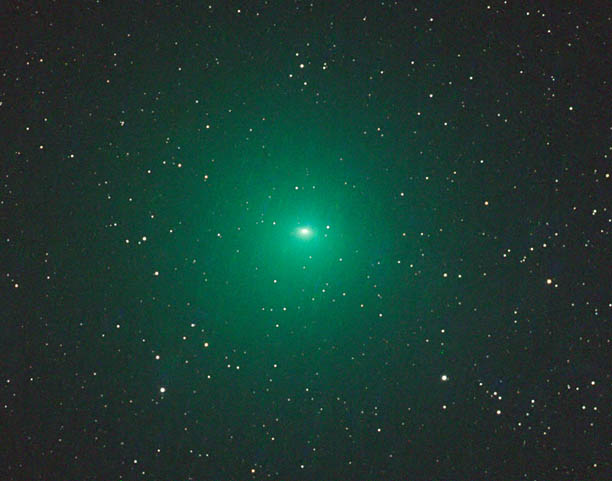Contacts:
J. Kelly Beatty, Senior Editor
855-638-5388 x22168, [email protected]
Alan M. MacRobert, Senior Editor
855-638-5388 x22151, [email protected]
| Note to Editors/Producers: This release is accompanied by publication-quality illustrations; details below. |
Astronomers who scan the skies for returning comets are often disappointed. Sometimes these icy visitors from the fringes of our planetary system end up being much fainter than predicted.
And sometimes the opposite happens. Comet LINEAR (formally designated 252P), now in Earth’s general vicinity, started brightening abruptly a few weeks ago and has become more than 100 times brighter than expected. Observers from the Southern Hemisphere have been able to glimpse the comet by eye, without any optical aid, from very dark skies.
Now Comet LINEAR is moving rapidly northward into view from the Northern Hemisphere. Our view won’t be as good — unfortunately, the Moon will flood the sky with nature’s own light pollution. But you might be able to find the comet with binoculars. You’ll need to be out at least 1½ hours before sunrise, in a location as free from light pollution as possible. Bring the accompanying sky chart and a dim light to read it by. The comet is moving between the distinctive constellations Sagittarius and Scorpius, located low in the southern part of the sky before dawn. Each morning the comet will be higher up with respect to the surrounding stars, as shown on the chart.
The planets Saturn and Mars are in this part of the sky as well. They and the bright star Antares will be the first things you notice, forming a distinctive triangle a little smaller than your clenched fist held at arm’s length. The comet is climbing to the left of this trio. It will be roughly in line with Mars and Saturn on the morning of March 29th and along a line connecting Saturn and Antares on March 31st. But the comet is faint enough, especially though the moonlight, that you’ll need to use the chart to pinpoint the exact spot among the stars to examine.
“Don’t expect Comet LINEAR to be obvious with a long tail,” explains Sky & Telescope Senior Editor Kelly Beatty. “Its light isn’t concentrated in a single point but instead is spread out in a soft round glow, larger than the Moon but many thousands of times dimmer.”
In fact, on March 30th the Moon will be an extremely glary intrusion just 3° (about two finger-widths at arm’s length) to the comet’s lower right.
Photographs show that Comet LINEAR has a greenish color, caused by molecules of diatomic carbon (C2) that are fluorescing in sunlight. However, the green tint likely won’t be evident unless you view the comet through a telescope.
Given the comet’s unexpected surge, astronomers aren’t sure how long it will remain even binocular-bright. It passed closest to Earth, just 3.3 million miles away, on March 21st. Now it’s moving away from both Earth and the Sun.
Another small visitor, called Comet PanSTARRS (designated P/2016 BA14), passed even closer to Earth — about 2.2 million miles away — on March 22nd. It is also crossing our skies now but is too faint to be seen except with a large backyard telescope. The timing of these paired visits is probably no coincidence. The "P" in both comets’ designations means they are in periodic (elliptical) orbits that bring them near the Sun repeatedly, in this case about every 5 years. Their orbits are so similar that comet specialists suspect these two bodies are fragments of a single object.
LINEAR is an acronym for Lincoln Near Earth Asteroid Research, an MIT Lincoln Laboratory program funded by the U.S. Air Force and NASA. Its team discovered Comet 252P on April 7, 2000. PanSTARRS stands for Panoramic Survey Telescope & Rapid Response System, a wide-field imaging telescope developed by the University of Hawaii's Institute for Astronomy. Its team discovered Comet P/2016 BA14 on January 22, 2016, and the alphanumeric designation indicates that astronomers initially believed this object to be an asteroid. The ice-rich cores, or nuclei, of these two bodies are roughly 3,000 feet (1 km) and 350 feet (100 meters) across, respectively.
Now in its 75th year of publication, Sky & Telescope is recognized worldwide as a trusted, authoritative resource for astronomy news, stargazing, and telescopic equipment. Sky & Telescope and SkyandTelescope.com are divisions of F+W, a content and e-commerce company.
Permission is granted for one-time, nonexclusive use of the illustrations below in print and broadcast media, as long as appropriate credit (as noted in each caption) is included. Web publication must include a link to SkyandTelescope.com.

Sky & Telescope diagram

Gerald Rhemann / www.astrostudio.at
 1
1